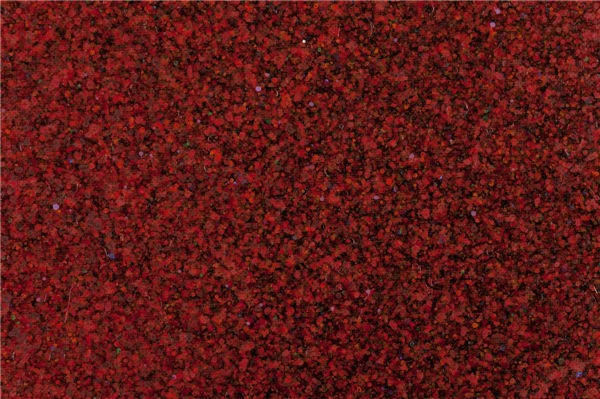

Red Obscure, 2010, by Jiang Dahai.
However, Jiang refused. "If I show these paintings to French people, they will look down upon these paintings", he said. "These paintings are good, of course, but it has nothing to do with French art circles. It's just a market thing."
Having gone through a two to three years' transition period, he gradually stepped into exploring abstractionism. At first, he tried the abstract way to express the clouds in France, which are always in various shapes and colors.
During that time, he lived in an international art district in downtown Paris, and coincidently a window of his room faced an old wall. The dilapidated wall was not repaired or decorated to keep its original look. One day, he tried to portray the wall using a realistic approach, and when he finished, he suddenly found that the painting looked like an abstract one. Therefore, he took this as his first real abstract painting, and regarded this as an important step in his transition from Realism to Modernism.
However, the way to abstractionism was arduous in the beginning. The French market was hard to break into, especially for foreign artists who want to be accepted by French art circles.
It took him almost 10 years to totally gain a firm foothold in the abstract art market. Money he earned from selling earlier oil paintings helped him manage through the hard time.
During his study in the West, Jiang said that Mark Rothko, the American abstract artist, influenced him a lot. From him Jiang said he began to realize the leading role of math and geometry in the art, and also the significance of philosophy in art creation. Also, he made a systematic study of color theory in France.
When learning Western art, he also tried to integrate Chinese cultural essence into his abstract art, and attempted to establish his own style.
Before he used the technique of dripping, he tried other ways, such as Chinese freehand drawing, pouring ink or stippling using a loofa sponge, and finally adopted his current technique.
Henry-Claude Cousseau described Jiang's painting technique as "A gesture of a hand that, with a brief stroke of the wrist, allows the brush to scatter a fine rain of drops that stain the painted surface of the canvas with delicacy."
Jiang holds that Chinese painting is more freewheeling and obscure, which is based on the Chinese philosophy of Taoism, Qi (energy force or vital force) and Zen. Qi is vital for Chinese art, and without it, art is dead. That's why we can always see and feel a kind of Qi rising in his paintings.
Henry-Claude Cousseau, commented, "Jiang Dahai is not only a painter, but also a philosopher. Through his paintings, we can see a boundless universe with infinite light, and can't help being attracted by."
If you go:
From Nov 16 to Jan 8, 2015
Yishu 8, Former Sino-French University, NO 20 (jia), Dong Huangchenggen Bei Jie, Dongcheng district, Beijing
+86 (10) 6581 9058
Copyright ©1999-2018
Chinanews.com. All rights reserved.
Reproduction in whole or in part without permission is prohibited.